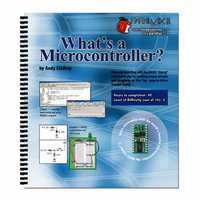28123 Parallax Inc, 28123 Datasheet - Page 112

28123
Manufacturer Part Number
28123
Description
TEXT WHAT'S A MICROCONTROLLER
Manufacturer
Parallax Inc
Type
Programmingr
Datasheet
1.28123.pdf
(340 pages)
Specifications of 28123
Style
Book
Title
What's a Microcontroller?
Contents
Whats a Microcontroller? Text
Product
Microcontroller Accessories
Core Processor
PIC16C57c
Flash
128 Bytes
Operating Supply Voltage
9 V
Board Size
31 mm x 16 mm
Lead Free Status / RoHS Status
Not applicable / Not applicable
- Current page: 112 of 340
- Download datasheet (6Mb)
Chapter #4: Controlling Motion · Page 103
Chapter #4: Controlling Motion
MICROCONTROLLED MOTION
Microcontrollers make sure things move to the right place all around you every day. If
you have an inkjet printer, the print head that goes back and forth across the page as it
prints is moved by a stepper motor that is controlled by a microcontroller. The automatic
grocery store doors that you walk through are controlled by microcontrollers, and the
automatic eject feature in your VCR or DVD player is also controlled by a
microcontroller.
ON/OFF SIGNALS AND MOTOR MOTION
Just about all microcontrolled motors receive sequences of high and low signals similar
to the ones you’ve been sending to LEDs. The difference is that the microcontroller has
to send these signals at rates that are usually faster than the eye can detect. The timing
and number of separate high/low signals differ from one motor to the next, but they can
all be controlled by microcontrollers capable of delivering the high/low signals.
Some of these motors require lots of circuitry to help the microcontroller make them
work. Other motors require extra mechanical parts to make them work right in machines.
Of all the different types of motors to start with, the hobby servo that you will experiment
with in this chapter is probably the simplest. As you will soon see, it is easy to control
with the BASIC Stamp, requires little or no additional circuitry, and has a mechanical
output that is easy to connect to things to make them move.
ACTIVITY #1: CONNECTING AND TESTING THE SERVO
In this activity, you will connect a servo to a power supply and the BASIC Stamp. You
will then verify that the servo is functioning properly by programming the BASIC Stamp
to send signals to the servo that will control the servo’s position.
Introducing the Servo
Figure 4-1 shows a drawing of a Parallax Standard Servo. The plug (1) is used to connect
the servo to a power source (Vdd and Vss) and a signal source (a BASIC Stamp I/O pin).
The cable (2) conducts Vdd, Vss and the signal line from the plug into the servo. The
horn (3) is the part of the servo that looks like a four-pointed star. When the servo is
running, the horn is the moving part that the BASIC Stamp controls. The case (4)
Related parts for 28123
Image
Part Number
Description
Manufacturer
Datasheet
Request
R

Part Number:
Description:
Microcontroller Modules & Accessories DISCONTINUED BY PARALLAX
Manufacturer:
Parallax Inc

Part Number:
Description:
BOOK UNDERSTANDING SIGNALS
Manufacturer:
Parallax Inc
Datasheet:

Part Number:
Description:
COMPETITION RING FOR SUMOBOT
Manufacturer:
Parallax Inc
Datasheet:

Part Number:
Description:
TEXT INFRARED REMOTE FOR BOE-BOT
Manufacturer:
Parallax Inc
Datasheet:

Part Number:
Description:
BOARD EXPERIMENT+LCD NX-1000
Manufacturer:
Parallax Inc
Datasheet:

Part Number:
Description:
CONTROLLER 16SERVO MOTOR CONTROL
Manufacturer:
Parallax Inc
Datasheet:

Part Number:
Description:
BASIC STAMP LOGIC ANALYZER
Manufacturer:
Parallax Inc
Datasheet:

Part Number:
Description:
IC MCU 2K FLASH 50MHZ SO-18
Manufacturer:
Parallax Inc
Datasheet:














